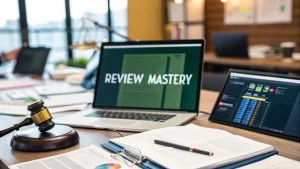Internal document reviews often present significant challenges in modern workflows, leading to inefficiencies and miscommunication. Teams frequently grapple with unclear guidelines and inconsistent feedback, which can hinder progress. Streamlining these reviews is essential for enhancing collaboration and productivity. By exploring targeted strategies and technological solutions, organizations can transform their review processes. This analysis will uncover practical approaches to foster accountability and improve outcomes, ultimately reshaping how teams function in a fast-paced environment.
Key Takeaways
- Establish clear guidelines and deadlines for document formatting and review timelines to enhance efficiency and accountability.
- Utilize collaborative platforms for real-time feedback, ensuring all team members can contribute simultaneously to reduce bottlenecks.
- Create a centralized repository for easy access and tracking of documents, streamlining the review process and reducing confusion.
- Conduct regular check-ins to maintain momentum and ensure the review process stays on track, fostering open communication among team members.
- Measure the impact of streamlined reviews through metrics like turnaround time and team satisfaction to identify areas for improvement.
Understanding the Challenges of Internal Document Reviews
When organizations engage in internal document reviews, they often encounter a myriad of challenges that can hinder efficiency and productivity. These obstacles frequently stem from unclear guidelines, inconsistent feedback, and the overwhelming volume of documentation requiring attention. Additionally, teams may struggle with inadequate collaboration tools, leading to miscommunication and duplicative efforts. The complexity of tracking revisions and maintaining version control further complicates the process, resulting in frustration and delays. To address these issues, organizations must recognize the significance of streamlining internal document reviews. By identifying and tackling these challenges head-on, they can foster a more cohesive environment where every team member feels valued, ultimately enhancing overall productivity and contributing to a sense of belonging within the workplace.
Key Strategies for Streamlining Internal Document Reviews
Effective strategies for streamlining internal document reviews can greatly enhance organizational efficiency and collaboration. Establishing clear guidelines for document formatting and review timelines fosters consistency and sets expectations. Encouraging open communication among team members promotes a culture of feedback, allowing for constructive critique and quicker resolution of issues. Implementing a designated review team guarantees accountability and expertise, while regular check-ins keep the process on track. Additionally, creating a centralized repository for documents simplifies access and tracking. Prioritizing essential documents and leveraging a tiered review process can help focus efforts on critical content. By adopting these strategies, organizations can cultivate a more cohesive environment, ultimately driving improved productivity and greater team engagement in internal document reviews.
Leveraging Technology to Enhance Review Processes
The integration of technology into the review process represents a transformative step in streamlining internal document reviews. Advanced tools such as collaborative platforms and automated workflow systems facilitate real-time feedback and enhance communication among team members. These technologies allow for simultaneous input from multiple reviewers, greatly reducing bottlenecks and expediting the overall review timeline. In addition, integration with document management systems guarantees that all revisions are tracked meticulously, providing transparency and accountability. By harnessing artificial intelligence, organizations can prioritize documents needing urgent attention, thereby optimizing resource allocation. Ultimately, leveraging technology not only enhances the efficiency of internal reviews but also fosters a culture of collaboration, belonging, and shared purpose among team members as they navigate the complexities of document evaluation together.

Best Practices for Effective Collaboration During Reviews
Although collaboration during document reviews can often be challenging, implementing best practices can greatly enhance the process. Establishing clear objectives and roles is essential; this guarantees that all participants understand their responsibilities and the review’s goals. Utilizing collaborative tools, such as shared platforms, fosters transparency and real-time communication, allowing team members to provide feedback efficiently. Additionally, setting deadlines for reviews promotes accountability and helps maintain momentum. Encouraging open dialogue and constructive criticism cultivates a supportive environment where diverse perspectives are valued. Finally, summarizing feedback and decisions in a central document guarantees that everyone is aligned, reducing the chances of miscommunication. By adopting these best practices, teams can notably streamline internal document reviews, enhancing collaboration and overall productivity.
Measuring the Impact of Streamlined Document Reviews on Productivity
Streamlining internal document reviews can have a profound impact on productivity across various teams and organizations. By implementing structured processes and utilizing collaborative tools, organizations can considerably reduce review times and enhance the quality of feedback. Metrics such as turnaround time, error rates, and team satisfaction can effectively measure this impact. For instance, a reduction in document review cycles often correlates with faster project completions, fostering a sense of achievement among team members. Additionally, improved clarity in the review process can lead to better alignment on project goals, creating an inclusive environment where everyone feels valued. Ultimately, these streamlined reviews not only boost productivity but also strengthen team cohesion, reinforcing a culture of collaboration and shared success.
Frequently Asked Questions
What Types of Documents Benefit Most From Streamlined Reviews?
Legal contracts, project proposals, and marketing materials benefit most from streamlined reviews. Such documents often require multiple approvals and feedback, making efficient processes essential for enhancing collaboration, reducing delays, and improving overall productivity within teams.
How Can I Get My Team on Board With New Review Processes?
To gain team support for new review processes, clear communication of benefits, inclusive training sessions, and a collaborative approach to implementation are essential. Engaging team members fosters ownership and enhances commitment to the changes introduced.
What Tools Are Best for Remote Document Reviews?
Effective tools for remote document reviews include collaborative platforms like Google Docs, Microsoft Teams, and Asana, which facilitate real-time feedback, enhance communication, and streamline internal document reviews, fostering a cohesive team environment and improving overall productivity.
How Often Should Document Review Processes Be Evaluated?
Document review processes should be evaluated quarterly to guarantee efficiency and relevance. Regular assessments allow organizations to adapt to changing needs, enhance collaboration, and ultimately foster a culture of continuous improvement and shared success among teams.
Can Streamlining Reviews Reduce Overall Project Timelines?
Streamlining internal document reviews can greatly reduce overall project timelines by eliminating bottlenecks and enhancing collaboration. This efficient approach fosters a sense of belonging among team members, ultimately leading to improved productivity and successful project completion.
Conclusion
To summarize, streamlining internal document reviews is essential for enhancing productivity in modern workflows. By understanding the challenges and implementing key strategies—such as leveraging technology and fostering collaboration—teams can greatly reduce review times and improve overall efficiency. The establishment of clear guidelines and centralized repositories not only promotes accountability but also enhances team cohesion. Ultimately, these efforts lead to quicker project completions and a more dynamic work environment, benefiting both the organization and its employees.
You May Also Like To Read:





